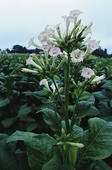Radioactivity in Tobacco
Radiation Facts
- The tobacco used to make cigarettes and other tobacco products contains trace amounts of radioactive elements.
The fertilizers that tobacco farmers use to increase the size of their tobacco crops contain the naturally-occurring radionuclide radium and its decay products. As the plant grows, the radon from fertilizer, along with naturally-occurring radon in surrounding soil and rocks, transfer into and on the plant and are later included in tobacco products made from these plants. Radon’s decay product, polonium-210, carries the most risk.
About Radioactivity in Tobacco
 The sticky underside of tobacco leaves hold radionuclides that come from fertilizer.
The sticky underside of tobacco leaves hold radionuclides that come from fertilizer.
Source: National Institutes of Health (NIH)
You have probably heard plenty of reasons not to smoke or use other tobacco products, but here is one more: The tobacco used to make these tobacco products contains trace amounts of radionuclides. One in five deaths each year in the United States are from tobacco use or secondhand smoke exposure—that’s around 480,000 people annually or 1,300 people every day. Toxic chemicals in tobacco smoke are the main reason cigarettes cause cancer, but radiation also may play a part.
Tobacco farmers use fertilizer to help their crops grow. These fertilizers contain a naturally-occurring radionuclide, radium. Radium radioactively decays to release radon gas, which then rises from the soil around the plants. As the plant grows, the radon from fertilizer, along with naturally-occurring radon in surrounding soil and rocks, cling to the sticky hairs on the bottom of tobacco leaves, called trichomes. Radon later decays into the radioactive elements lead-210 and polonium-210. Rain does not wash them away. Polonium-210 is an alpha emitter and carries the most risk. Learn the radiation basics.
Cigarettes made from this tobacco still contain these radioactive elements. The radioactive particles settle in smokers’ lungs, where they build up as long as the person smokes. Over time, the radiation can damage the lungs and can contribute to lung cancer. Using tobacco products can also make users more vulnerable to other cancer-causing contaminants. For example, radon is a colorless, odorless, radioactive gas occurs naturally in soils. Radon can seep into houses, schools and other buildings through cracks in the foundation. Inhaling it over time can cause lung cancer. Smokers exposed to radon are more likely to develop lung cancer than non-smokers. Learn more about Radon in Homes, Schools and Buildings.
What You Can Do
- Do not chew or smoke tobacco. This helps to avoid the health effects from chemicals and radiation in tobacco products.
- Stay away from secondhand smoke as much as you can. This helps to limit your exposure to chemicals and radiation from tobacco products used by others.
